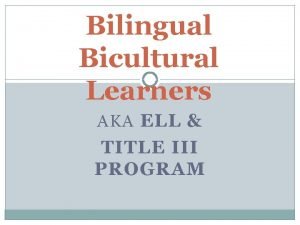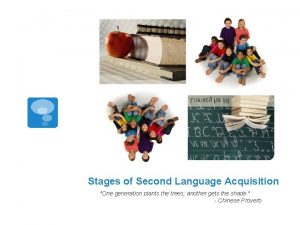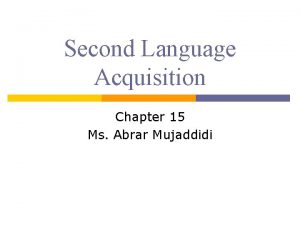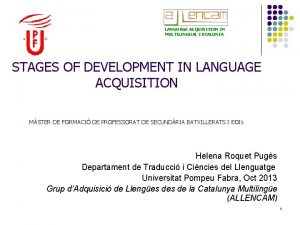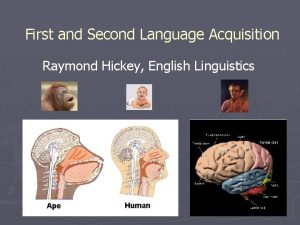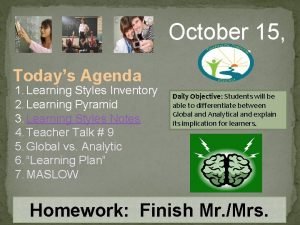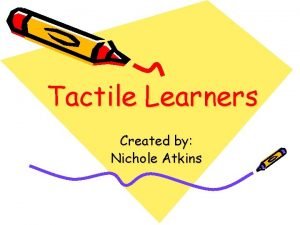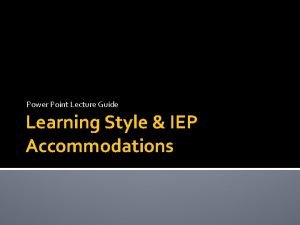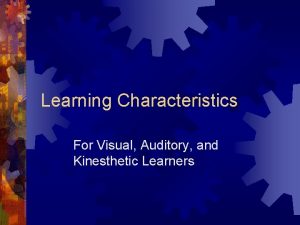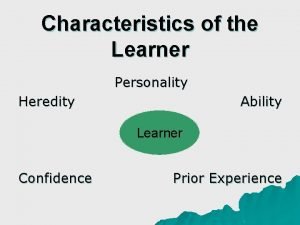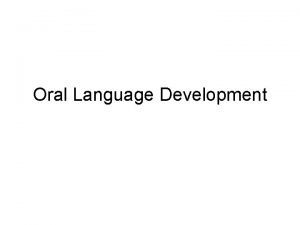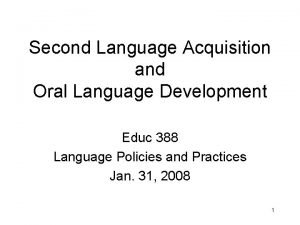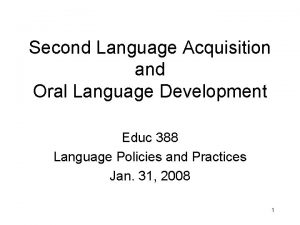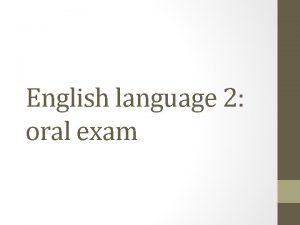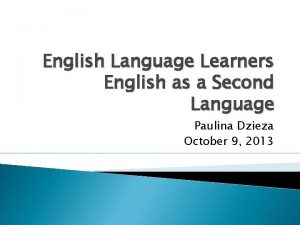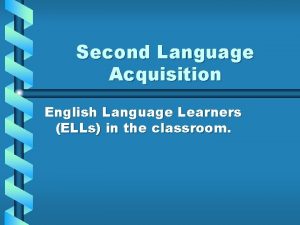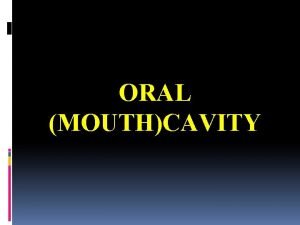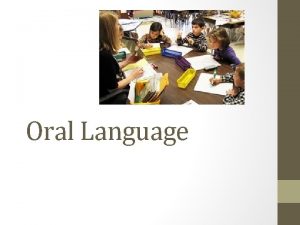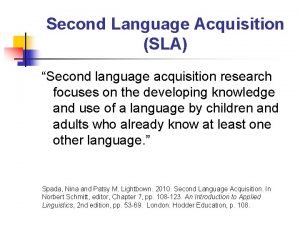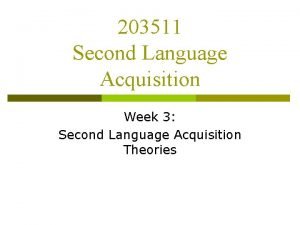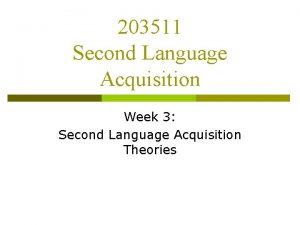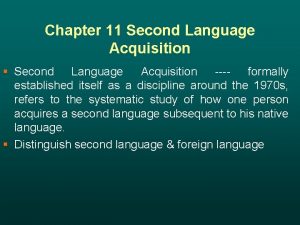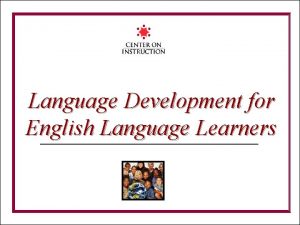Oral Language Development Second Language Learners Oral Language





















- Slides: 21

Oral Language Development Second Language Learners

Oral Language in Perspective We listen a book a day, talk a book a week, read a book a month, and write a book a year. Loban, 1980 Oral language is so pervasive, we take it for granted. It is the bulk of our day-to-day communications and the primary mode for discourse throughout the world.

Oral Language and ESL Learners • Students need to engage in: – Task-directed talk – Teacher talk – Student-to-student talk – Group talk – Meaningful, contentbased talk

Listening, Speaking, Reading The Relationship • Oral and written language must be integrated • Oral and written language usually occur together naturally • They intermingle as we go about our daily lives

Listening, Speaking, Reading The Relationship • L 1 Acquisition: – Children become grammatically competent speakers by about age 5 – Vocabulary expansion continues at a rapid pace – Competence in reading and writing occurs much later – Oral language development occurs much faster and earlier

Listening, Speaking, Reading The Relationship • L 2 Acquisition: – For those with little L 1 literacy, basic oral language competence is likely to emerge earlier than competence in reading/writing – For older students, the pattern reverses – written English proficiency will develop first, then oral – Students do not need to be fully competent oral English speakers in order to read in L 2

Receptive v. Productive • Receptive uses of language: – Listening – Reading • Messages are received by ear or by eye • Meaning is reconstructed based partly on prior knowledge • Active process • Productive uses of language: – Speaking – Writing • Messages are produced • Messages are created for an audience • Both active and passive process

Interrelationships Listening Receptive Speaking Dynamic Interrelationships among Oral and Written Language Productive Reading Writing Receptive Productive

Learning Opportunities Must Include all Four Processes • We move back and forth between oral and written modes during communication • This type of recursive process must be present in the classroom • Practical use of each language process provides: – Specific development in each – Promotes overall language development

Form, Function, and Social Context in Oral Language Use • Teachers must consider: – Grammatical forms – Communicative functions – Social contexts • When and why to use certain types of language forms • Places different cognitive and social demands – Formal aspects of language • Phonology, morphology, syntax

Halliday’s Functional Categories • • Instrumental Regulatory Interactional Personal Heuristic Imaginative Informative Divertive Chart – pg 110

Oral Language Performance • Term: LEP – Limited English Proficiency – Beginning LEP • Non-English speakers • Beginning speakers – Intermediate LEP • Limited, but functional • Functional – Be sure to offer choice for more advanced activities

L 2 Oral Proficiency - Beginners • Beginner phase starts immediately upon exposure to L 2 • Soon after, comprehension develops • Speaking occurs naturally shortly after – Utterances according to simple grammatical rules – Voice needs and purposes in formal and informal school settings • Provide social-emotional support from: – Teacher and other students

L 2 Proficiency - Intermediate • Are able to understand speak English in fact -to-face situations • Speak with minimal hesitation • Relatively few misunderstandings • Some features of speech are not Standard English • Teachers must: – Control need to constantly correct – Show interest by asking questions – Continue with sheltering activities

Promoting Oral Language Development in L 2 • Organize classroom to promote: – Comprehensible input – Social interaction • Utilize routine instructional events: – Circle time – Literature circles – Process Writing – Projects – Theme Studies • Maintain consistent structure • Incorporate: – – – Cues to convey meaning Non-verbal cues Dramatization Gestures Pictures, realia Verbal Strategies such as paraphrasing, repeating vocabulary, and modeling

Classroom Strategies • • • Songs Dramatizing Poetry Show and Tell Tape Recording and Recreating Wordless Books Taping a Newscast or TV Show Choral Reading Reader’s Theater Riddles and Jokes Literature Groups/Circles

Oral Language and Math • Utilize: – Demonstration of concepts – Extensive use of manipulatives – Problem solving – Word problems – Math Vocabulary and language – Group work

Oral Development and Science • Utilize: – Cognitive demanding scientific language – Process-oriented activities (data collection, problem solving) – Inquiry-based Science • Investigating real problems • Hands-on activities • Group work that promotes talking and dialoging • Keep in mind: prior knowledge and cultural assumptions within the field of Science

Oral Development and Social Studies • Utilize: – – Verbal descriptions Films and discussions Storytelling Family histories and oral traditions – Group discussions – Pictures, graphs, flow charts, organizers – Simulations • Remember to: – Present content using visuals – Incorporate analysis and dialog

The SOLOM – Student Oral Language Observation Matrix • Focuses on five traits: – – – Comprehension Fluency Vocabulary Grammar Pronunciation • Create checklists using the SOLOM • Utilized during day-today observations • Assists in creating a rich profile of student progress

Checklists and Anecdotal Records • Forms and checklists should address: – Participation Structures • Interaction patterns • Group interactions – Language functions • Day-to-day interactions • Formal and informal – Linguistic Elements • Grammar • Pronunciation • Student’s ability to utilize these in discourse
 Assistive technology for english language learners
Assistive technology for english language learners English language learners
English language learners Reading strategies for english language learners
Reading strategies for english language learners Equal protection for english language learners
Equal protection for english language learners Speech emergence examples
Speech emergence examples 186 282 miles per second into meters per second
186 282 miles per second into meters per second Second language vs foreign language
Second language vs foreign language Difference between second language and foreign language
Difference between second language and foreign language Difference of first language and second language
Difference of first language and second language Difference of first language and second language
Difference of first language and second language Global vs analytical learners
Global vs analytical learners What is grammar
What is grammar Heather nichole atkins
Heather nichole atkins A teacher should adopt “remedial teaching” for:
A teacher should adopt “remedial teaching” for: Global vs analytical learners
Global vs analytical learners Kinesthetic characteristics
Kinesthetic characteristics Lazy and eager learning in machine learning
Lazy and eager learning in machine learning Learn to learn
Learn to learn When is cognitivism beneficial for learners
When is cognitivism beneficial for learners What is global-analytic continuum
What is global-analytic continuum Resolution no. 435 series of 1997 pdf
Resolution no. 435 series of 1997 pdf Characteristic of learners
Characteristic of learners

